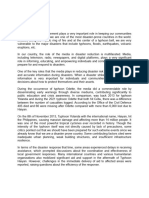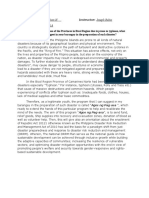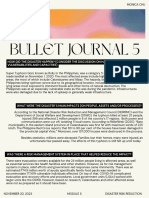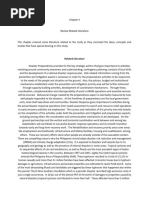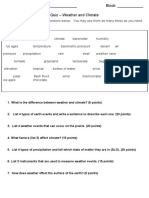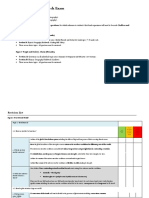Case Study
Case Study
Uploaded by
Micaela GerondioCopyright:
Available Formats
Case Study
Case Study
Uploaded by
Micaela GerondioCopyright
Available Formats
Share this document
Did you find this document useful?
Is this content inappropriate?
Copyright:
Available Formats
Case Study
Case Study
Uploaded by
Micaela GerondioCopyright:
Available Formats
Jhon Kent Lantaco BSDRM-D
Case Study: Typhoon Haiyan (Yolanda) – Philippines
Background of the Disaster
Time: November 8, 2013
Location: Central Philippines (Eastern Visayas, Leyte, Samar, and surrounding regions)
Impact: Typhoon Haiyan (locally known as Yolanda) was one of the strongest tropical cyclones ever
recorded, with winds reaching 315 km/h (195 mph). The storm triggered massive storm surges up to 6
meters high, flooding coastal areas and devastating towns and cities. Over 6,300 people were killed,
more than 28,000 were injured, and approximately 1,800 were reported missing. About 4 million people
were displaced, and the economic damage was estimated at $14 billion, affecting homes, livelihoods,
and infrastructure.
What financing or insurance mechanisms were in place prior to the disaster?
Before Typhoon Haiyan, the Philippines had several disaster risk financing and insurance mechanisms in
place, but they were limited in their capacity to cope with a disaster of such magnitude:
Philippine Disaster Risk Reduction and Management Act (2010):
This legislation established the National Disaster Risk Reduction and Management Council (NDRRMC),
which coordinates disaster preparedness, response, and recovery. It mandated local governments to
allocate 5% of their Internal Revenue Allotment (IRA) to the Local Disaster Risk Reduction and
Management Fund (LDRRMF) for disaster risk reduction (DRR) activities and response.
Government Catastrophe Insurance
The Philippine government had a limited catastrophe insurance program to protect public assets (e.g.,
schools, hospitals, and government buildings) against natural disasters like typhoons, floods, and
earthquakes. This program provided some protection for government infrastructure but was not
extensive enough to cover all public assets or immediate recovery needs.
Private Insurance:
Private insurance in the Philippines was underdeveloped, with low penetration rates, especially in rural
areas. While some businesses and wealthy households had property insurance that included typhoon
coverage, a large proportion of the population, particularly in highly vulnerable areas, were not insured.
How did these mechanisms support the recovery process?
Government Response and Local Disaster Funds:
The national government, through the NDRRMC, quickly mobilized resources from the National Disaster
Risk Reduction and Management Fund (NDRRMF) for emergency response, including providing food,
water, medical assistance, and temporary shelter. Local governments used their Local Disaster Risk
Reduction and Management Funds (LDRRMF) to initiate relief operations; however, many local
governments, especially in severely affected areas, exhausted their funds quickly due to the
overwhelming scale of the disaster..
Private Insurance:
The insurance payouts from private insurers were limited, as most affected people in the disaster-prone
areas did not have typhoon insurance coverage. However, businesses and homeowners who were
insured received payouts that helped finance rebuilding efforts, although the insurance sector struggled
to cope with the massive claims.
Post-disaster Recovery and Rehabilitation:
The Philippine government, with support from international financial institutions and foreign
governments, launched a comprehensive rehabilitation program called “Build Back Better” to rebuild
homes, infrastructure, and livelihoods in affected areas. A series of supplemental budgets were enacted
to finance the long-term recovery, which included housing reconstruction, road repairs, and livelihood
programs.
What lessons were learned from this event about the role of disaster risk
financing and insurance?
One of the main lessons from Typhoon Yolanda was the lack of sufficient insurance coverage,
particularly among the poor and rural populations. The government and private sector recognized the
need to expand insurance coverage for vulnerable populations to improve financial resilience. Micro-
insurance initiatives have since gained traction, offering low-cost insurance products tailored to the
needs of lower-income households.
.
Strengthening of Public Asset Insurance:
The need to expand and strengthen the government’s insurance coverage for public infrastructure
became evident. The significant damage to schools, hospitals, and roads put immense pressure on
recovery efforts. Following Typhoon Haiyan, the Philippine government has worked to expand its
catastrophe insurance program to include a broader range of public assets.
Emphasis on Risk Reduction and Resilience Building:
The scale of destruction prompted a shift in focus from disaster response to disaster preparedness and
resilience-building. The Build Back Better approach emphasized constructing more resilient
infrastructure, reinforcing coastal defenses, and adopting climate-resilient agriculture and livelihood
practices. Additionally, early warning systems were enhanced to better prepare communities for future
disasters.
You might also like
- Disaster Risk Reduction and ManagementDocument4 pagesDisaster Risk Reduction and Managementpadmeshm920822243038No ratings yet
- Reaction Paper NOTESDocument11 pagesReaction Paper NOTESKatrina Felene Barrios100% (4)
- Position Paper Group BDocument3 pagesPosition Paper Group BUlysses John Pagente AlmoceraNo ratings yet
- DRRM & How To Survive in A DisasterDocument12 pagesDRRM & How To Survive in A Disasteresyangestores.wmsu.edu.phNo ratings yet
- Lesson 6 DMHDocument3 pagesLesson 6 DMHCala WritesNo ratings yet
- Argumentative EssayDocument4 pagesArgumentative EssayKeirstine Honey LimNo ratings yet
- Gem Sanga NSTPDocument4 pagesGem Sanga NSTPgemrsangaNo ratings yet
- Typhoon Yolanda Reflection EssayDocument1 pageTyphoon Yolanda Reflection EssayKathrina DelicanaNo ratings yet
- NSTPDocument4 pagesNSTPNala De LeonNo ratings yet
- DRRR News ArticleDocument4 pagesDRRR News ArticleNovelyn AppillanesNo ratings yet
- EssayDocument2 pagesEssayMaria Lourdes Donadillo VelardeNo ratings yet
- Activities of The Government To Reduce Disasters (DRR)Document2 pagesActivities of The Government To Reduce Disasters (DRR)jomartrinidad777No ratings yet
- Background of The StudyDocument8 pagesBackground of The StudysummymananganNo ratings yet
- Seminar Setting: ObjectivesDocument34 pagesSeminar Setting: ObjectivesMary CallejaNo ratings yet
- Assessment 2 Disaster Risk Management AB ELS 1A Lamadrid James Ivan HDocument2 pagesAssessment 2 Disaster Risk Management AB ELS 1A Lamadrid James Ivan HAnthony GiliNo ratings yet
- Thesis1 5 3Document85 pagesThesis1 5 3travisagpasa123No ratings yet
- Nstp-Cwts Module 4Document10 pagesNstp-Cwts Module 4JUAN VICTOR MACADANGDANGNo ratings yet
- Related Literature UpdatedDocument5 pagesRelated Literature UpdatedBibiNo ratings yet
- AO 17 Omnibus Guideliness On Shelter AssistanceDocument28 pagesAO 17 Omnibus Guideliness On Shelter Assistancejavillojanica01No ratings yet
- Disaster Risk Reduction and Management AwarnessDocument33 pagesDisaster Risk Reduction and Management AwarnessElisha Sabado100% (1)
- MODULE 1 - Philippine Natural and Man Made DisastersDocument15 pagesMODULE 1 - Philippine Natural and Man Made DisastersayeyedumpNo ratings yet
- 4-5 NSTPDocument22 pages4-5 NSTPANGEL HOPE MACEDANo ratings yet
- Disaster Plan For Typhoon Signal No. 4: Alexandria Canlas Ayumi Nakao Angel Godilano Kaye VirreyDocument5 pagesDisaster Plan For Typhoon Signal No. 4: Alexandria Canlas Ayumi Nakao Angel Godilano Kaye VirreySydney CanlasNo ratings yet
- Typhoon RaiDocument4 pagesTyphoon Raichloe24No ratings yet
- Acantilado Editorial CartoonDocument3 pagesAcantilado Editorial CartoonANGELINE ACANTILADO100% (1)
- Final Activity 1Document16 pagesFinal Activity 1castrojonalyn050106No ratings yet
- Disaster Preparedness and Local Governance in The PhilippinesDocument18 pagesDisaster Preparedness and Local Governance in The PhilippinesCamille SantosNo ratings yet
- Chap 1Document5 pagesChap 1Christine SegundoNo ratings yet
- Hazard and MitigationDocument14 pagesHazard and MitigationShiela SaangNo ratings yet
- I HandaDocument6 pagesI Handaherdy.dimanlig89No ratings yet
- Philippines: Typhoons and Floods: Emergency AppealDocument8 pagesPhilippines: Typhoons and Floods: Emergency AppealShielamayflor Garcia VargasNo ratings yet
- Unit 4: Disast Er Risk Reduction An D ManagementDocument13 pagesUnit 4: Disast Er Risk Reduction An D ManagementMelanie GirayNo ratings yet
- Housing Recovery Outcomes After Typhoon Haiyan inDocument28 pagesHousing Recovery Outcomes After Typhoon Haiyan injolucnNo ratings yet
- Ramos, Revilla, Ressureccion, Rimando Philippine Response To CalamitiesDocument53 pagesRamos, Revilla, Ressureccion, Rimando Philippine Response To Calamitiesenimsay somarNo ratings yet
- MPA4Document7 pagesMPA4AnjnaKandariNo ratings yet
- Community-Based DRRM: Sto. Domingo, Quezon City, Philippines ExperienceDocument69 pagesCommunity-Based DRRM: Sto. Domingo, Quezon City, Philippines ExperienceJoyce SyNo ratings yet
- Disaster Risk Reduction and Management AwarenessDocument24 pagesDisaster Risk Reduction and Management AwarenessGil PerezNo ratings yet
- Written Work 3 Super Typhoon HaiyanDocument2 pagesWritten Work 3 Super Typhoon HaiyanSHANE MIJARESNo ratings yet
- New Microsoft Office Word DocumentDocument36 pagesNew Microsoft Office Word DocumentPrijeesh Naduvalath100% (1)
- News ReportDocument4 pagesNews ReportChaela GonzagaNo ratings yet
- DRRM Act Primer PDFDocument24 pagesDRRM Act Primer PDFBajunaid Malaco100% (1)
- Government Project PlanningDocument3 pagesGovernment Project PlanningRoland AlonzoNo ratings yet
- Disaster Response OperationsDocument67 pagesDisaster Response Operationsvlcejoco6429100% (2)
- Housing Recovery Outcomes After Typhoon Haiyan in The Philippines A Critical Realist PerspectiveDocument28 pagesHousing Recovery Outcomes After Typhoon Haiyan in The Philippines A Critical Realist PerspectiveSharina GNo ratings yet
- Zamboangacity State Polytechnic College Graduate SchoolDocument10 pagesZamboangacity State Polytechnic College Graduate SchoolJoanes OcamiaNo ratings yet
- Module 3 Disaster Awareness Preparedness and ManagementDocument53 pagesModule 3 Disaster Awareness Preparedness and ManagementEmmanuel Absuela Jr.No ratings yet
- Reaction PaperDocument3 pagesReaction PaperMyhen Grace QuebecNo ratings yet
- Primary Level Preparedness An Act ExpandDocument13 pagesPrimary Level Preparedness An Act ExpandMark Anthony AlcantaraNo ratings yet
- Philippine Disaster Risk Reduction and Management Act of 2010Document30 pagesPhilippine Disaster Risk Reduction and Management Act of 2010paescorpisoNo ratings yet
- Role of Media in Disaster ManagementDocument9 pagesRole of Media in Disaster ManagementRaqib Sofian100% (1)
- Monica Chu - Bullet Journal 5Document2 pagesMonica Chu - Bullet Journal 5mschuNo ratings yet
- Chapter 1 (BIND)Document17 pagesChapter 1 (BIND)Jimson Conde PerejaNo ratings yet
- World Health Organization Psychosocial Response After Typhoon Yolanda - DevAdmin Case StudyDocument19 pagesWorld Health Organization Psychosocial Response After Typhoon Yolanda - DevAdmin Case StudyLouin Adayo100% (1)
- What Happens After A Natural Disaster?: Week2Document12 pagesWhat Happens After A Natural Disaster?: Week2Phyo PyaeNo ratings yet
- NSTP DisasterDocument6 pagesNSTP DisasterAlexander III BalanayNo ratings yet
- Philippines' Country Profile : Tag-Ulan, The Rainy Season From June To November and Tag-Lamig, The Cool Dry Season FromDocument34 pagesPhilippines' Country Profile : Tag-Ulan, The Rainy Season From June To November and Tag-Lamig, The Cool Dry Season FromEugene Evan Endaya UyNo ratings yet
- Disaster Readiness & Risk Reduction (DRRR) : LM 01 - Basic Concept of DisasterDocument28 pagesDisaster Readiness & Risk Reduction (DRRR) : LM 01 - Basic Concept of DisasterHannah AlvarezNo ratings yet
- Related LiteratureDocument6 pagesRelated Literatureeriel.boolNo ratings yet
- Community Emergency Management, Disaster Recovery and ResilienceFrom EverandCommunity Emergency Management, Disaster Recovery and ResilienceNo ratings yet
- In Time Of Emergency: A Citizen's Handbook On Nuclear Attack, Natural DisastersFrom EverandIn Time Of Emergency: A Citizen's Handbook On Nuclear Attack, Natural DisastersNo ratings yet
- Weather and Climate PDFDocument17 pagesWeather and Climate PDFHermaelou CuranNo ratings yet
- Impact of Weather On Port and Shipping Performance in Berbera Somali LandDocument60 pagesImpact of Weather On Port and Shipping Performance in Berbera Somali LandJamal Omar Haji Raabi100% (1)
- Lesson Plan Weather DisturbancesDocument5 pagesLesson Plan Weather DisturbancesJay Contado100% (1)
- Weather Climate QuizDocument8 pagesWeather Climate QuizJeremie M. CruzNo ratings yet
- Weather ThesisDocument8 pagesWeather Thesislyjtpnxff100% (2)
- AvalanchesDocument19 pagesAvalanchesSohail SherNo ratings yet
- Ifathie L. Emam: P.O. Box 8692 Roxas Avenue, Isabela City, Basilan Province, 7300 PhilippinesDocument2 pagesIfathie L. Emam: P.O. Box 8692 Roxas Avenue, Isabela City, Basilan Province, 7300 PhilippinesLatifah EmamNo ratings yet
- IELTS Speaking Part 1 Collection 2016Document35 pagesIELTS Speaking Part 1 Collection 2016Phượng Phạm100% (1)
- How It Works Book of Incredible Earth - 2014 UKDocument180 pagesHow It Works Book of Incredible Earth - 2014 UKTony Bostanica94% (32)
- Climate Activity Name: - Score: - Activity 1. AtmosphereDocument3 pagesClimate Activity Name: - Score: - Activity 1. AtmosphereRevely DomdomNo ratings yet
- Pakmet Report On Sargodha Bhalwal TornadoDocument8 pagesPakmet Report On Sargodha Bhalwal TornadoGul HanifNo ratings yet
- Download The Little Ice Age How Climate Made History 1300 1850 Brian Fagan ebook All Chapters PDFDocument55 pagesDownload The Little Ice Age How Climate Made History 1300 1850 Brian Fagan ebook All Chapters PDFzsikcavene100% (2)
- Year 11 Geography Mock Exam Revision ListDocument6 pagesYear 11 Geography Mock Exam Revision ListGeoBlogsNo ratings yet
- Classroom Observation Tool: Science 9 Quarter 3Document42 pagesClassroom Observation Tool: Science 9 Quarter 3Joza Joy Eslabon Bacayo-AgtarapNo ratings yet
- Q2D4 Typhoon Formation and Tropical CycloneDocument28 pagesQ2D4 Typhoon Formation and Tropical Cycloneyumiyumieee83No ratings yet
- 11 Geography 2023-24Document2 pages11 Geography 2023-24adonlineclassmhssNo ratings yet
- De TT THPTQG 2 Anh 2324 de 191Document3 pagesDe TT THPTQG 2 Anh 2324 de 191MaiNo ratings yet
- SSRP PRINT FINAL Forecasting For Fishers Policy BriefingDocument4 pagesSSRP PRINT FINAL Forecasting For Fishers Policy BriefingMax MartinNo ratings yet
- Practice Test 17Document6 pagesPractice Test 17Nguyen CuongNo ratings yet
- Group4 DRR 15 Item QuizDocument2 pagesGroup4 DRR 15 Item QuizSerj ObenzaNo ratings yet
- 4th Quarter Test SCIENCE 4 No TOSDocument3 pages4th Quarter Test SCIENCE 4 No TOSarchietrinidad78No ratings yet
- Soal Bahasa Inggris Dan JawabannyaDocument5 pagesSoal Bahasa Inggris Dan JawabannyaToni WahyudiNo ratings yet
- Exam Practice: Unit 4: WeatherDocument8 pagesExam Practice: Unit 4: WeatherJean Andrea NiloNo ratings yet
- English9-Practice-Unit 9 284202023Document5 pagesEnglish9-Practice-Unit 9 284202023Nguyễn Tuấn ĐịnhNo ratings yet
- Meteorology 10 Homework 2 AnswersDocument4 pagesMeteorology 10 Homework 2 Answersafmsjaono100% (1)
- Test 2Document35 pagesTest 2Hoàng Hiển LongNo ratings yet
- 2017 Climate Change Multiple Choice QuestionsDocument7 pages2017 Climate Change Multiple Choice QuestionsMarkNo ratings yet
- Artificial Intelligence1.editedDocument15 pagesArtificial Intelligence1.editedMwangi Wa MutuaNo ratings yet
- 6th Grade Science End of Year ExamDocument34 pages6th Grade Science End of Year ExamMichelle TalleyNo ratings yet
- Thermal Stresses and Movements in Bridges PDFDocument54 pagesThermal Stresses and Movements in Bridges PDFMaitrabarun KarjeeNo ratings yet





